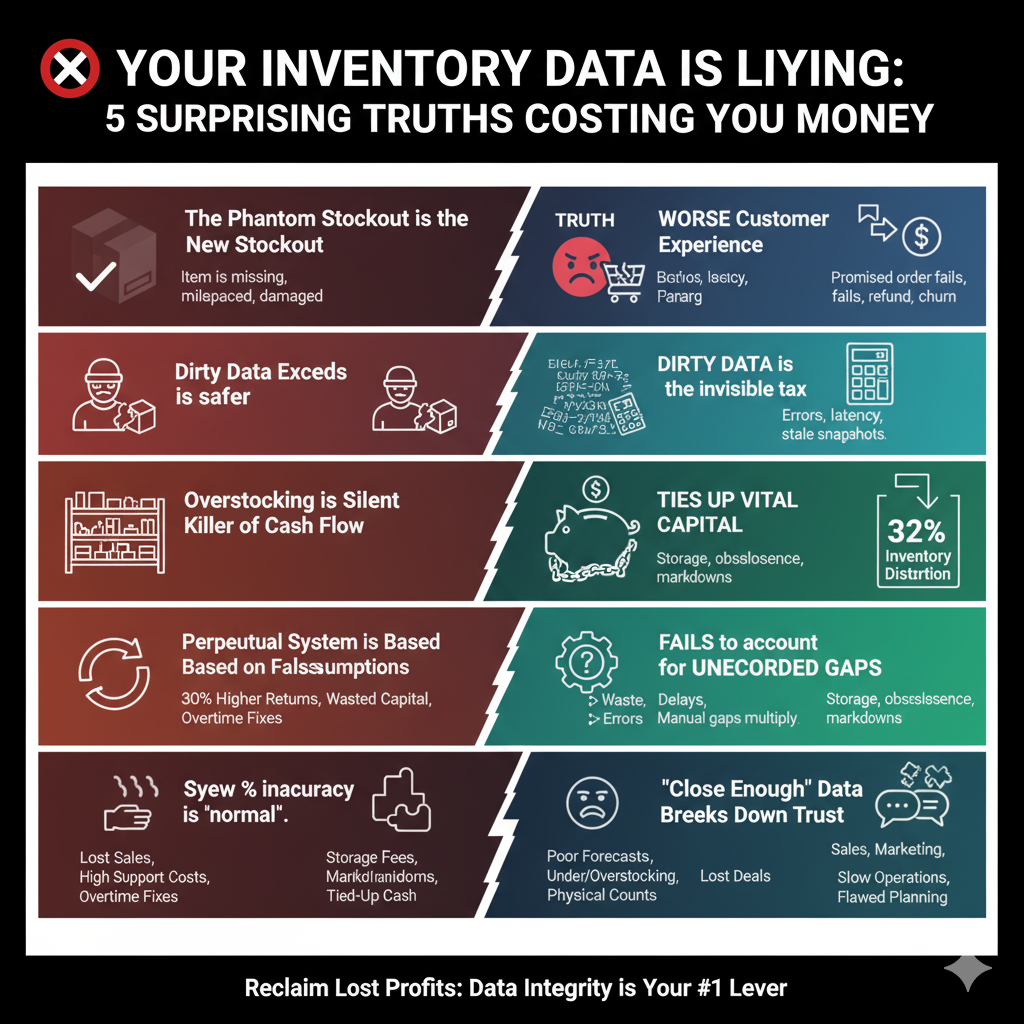It’s a scenario every
business owner knows too well: a customer wants to buy a popular item, but the
shelf is empty. You check your inventory system, which confidently reports you
have plenty in stock. The customer leaves frustrated, a sale is lost, and
you’re left scrambling. This moment of "phantom inventory" is more
than a minor glitch; it’s a symptom of a deeper, systemic failure. When your
system thinks an item is in stock, it triggers a "replenishment
freeze," completely halting the reordering process. This guarantees a
long-term stockout and creates a dangerous blind spot in your supply chain.
These moments are just
the tip of the iceberg. The real issues driving lost sales and shrinking
profits are often hidden in plain sight, masked by flawed data and misplaced
priorities. Conventional wisdom about inventory management simply isn't
equipped to address the true root causes of these costly problems.
This article will uncover five of the most surprising and impactful truths about inventory management. We will move beyond the obvious culprits to reveal that the real challenges are not what they seem. By understanding these hidden realities, you can begin to protect your business from the silent profit killers eroding your bottom line.
1. The Hidden Price
Tag: A Lost Item Costs Far More Than You Think
When an item
disappears from your inventory, it’s easy to calculate the loss based on its
cost. But this is a dangerous oversimplification. The counter-intuitive truth
is that the sticker price is the least of your worries. The immediate loss is
property, but the much larger, delayed loss is revenue. A single stockout
triggers a cascade of financial damage that harms your business long after the
item is gone.
The average retail
business can lose a staggering 4% of potential revenue due to out-of-stock
products. When faced with an empty shelf, customers don't always wait
patiently. In fact, 31% will choose to buy from another retailer, taking their
money and their loyalty to your competitor. The ripple effect of a single
missing item extends far beyond its value on the balance sheet.
In fact, revenue losses due to out-of-stocks can far outweigh the property losses due to the disappearing items.

This reframes "shrinkage" entirely. It is not a minor cost of goods sold problem to be written off at the end of the year. It is a direct threat to your top line, transforming into a revenue and customer retention crisis. Every lost item represents a lost opportunity to satisfy a customer, which is a cost far greater than the product itself.
2. Your System is
Wrong: The Shocking Unreliability of Inventory Records
We invest in
sophisticated systems to give us a clear, real-time picture of our stock. The
shocking reality, however, is that these records are often dangerously
inaccurate. This foundational error directly undermines automated
replenishment, demand forecasting, and nearly every strategic decision you
make.
Imagine making
critical business decisions knowing that the data for roughly half your
products is wrong from the start. A study of "Company A," a global
retailer, revealed this was exactly the case:
- Only about half the SKUs in their stores
had perfectly accurate inventory records.
- On average, the inventory record for one
out of every four SKUs deviated from the actual physical stock by six
or more items.
These discrepancies
aren't isolated incidents; they are the result of systemic issues that corrupt
data daily. The most common causes include:
- Stock loss (shrinkage): Theft, damage, or administrative loss
that goes unrecorded.
- Transaction errors: Mistakes at checkout, where a cashier
scanning one item multiple times corrupts the data for two separate SKUs.
- Inaccessible inventory: Items that are physically in the store
but lost on the wrong shelf, rendering them invisible to both customers
and replenishment systems.
- Incorrect product identification: Mislabeled products or wrong barcodes
that throw off counts at receiving or sale.
When the foundational data is this unreliable, every decision built upon it, from automated ordering to financial planning is compromised.
3. The
"Shrinkage Iceberg": The Biggest Threats Are Invisible
Like an iceberg, the
most visible part of inventory loss is only a fraction of the total problem.
The most significant, and therefore most dangerous, portion is the massive
amount of "unknown" loss that businesses cannot see, measure, or
explain.
This concept, known as
the "Shrinkage Iceberg," highlights a critical gap in business
intelligence. Research shows that for retailers in the Fast-Moving Consumer
Goods (FMCG) sector, an estimated 59% of all stock loss is classified as
"unknown." This means that companies cannot explain where, how,
or when nearly €10 billion of stock simply disappeared.
Without doubt, a
paucity of data plays a pivotal part in producing poor product protection.
This is a crucial takeaway for any manager. You cannot solve a problem you cannot see. The enormous category of "unknown" loss is not just a rounding error; it is a critical failure in data collection, tracking, and analysis. Without understanding the root causes of the majority of your losses, any attempt to fix the problem is simply guesswork, leaving your business vulnerable to threats that remain hidden beneath the surface.

4. The Misguided
Spotlight: Focusing on the Wrong Problems and Products
Many businesses pour
enormous resources into loss prevention, but their efforts are often critically
misdirected. The reason is simple: losses don't happen everywhere; they happen
in predictable hotspots. Yet, most companies take a "peanut butter"
approach, spreading resources thinly across the entire organization instead of
concentrating them where they matter most.
Losses are highly
concentrated in what are known as "Hot Products" (a small
number of high-risk items) and "Hot Stores" (a few high-loss
locations). These hotspots typically account for a disproportionate amount of
total shrinkage. Ignoring this data leads to wildly inefficient spending. For
example, one senior retail manager admitted that tackling shoplifting accounts
for about 95% of their security budget. This is a prime example of a
misguided spotlight, as external theft constitutes only about one-third of the
company's total losses, with internal theft and process failures being other
major contributors.
This insight is transformative. It allows businesses to shift from a broad, expensive approach to a targeted, data-driven strategy. By focusing resources on the true "Hot Spots," you can achieve far better results while using fewer resources.
5. The Human
Factor: Your Team is Your Most Powerful Inventory Tool
Technology and data
are essential, but they are only part of the solution. The most critical and
often overlooked factor in successful inventory control is your team. The
effectiveness of any system ultimately depends on the people who use it every
day.
A lack of
cooperation, both within departments and between supply chain partners is a
major barrier to reducing stock loss. When teams work in silos, processes break
down and accountability disappears. Conversely, organizations that build a
culture of shared ownership see dramatic improvements. The most effective
strategies are not punitive; they focus on earning employee buy-in by
connecting loss prevention to their success and work environment.
Consider implementing
concrete strategies to foster this culture:
- Explain to employees that loss prevention
is part of a plan to create a better work environment for them.
- Implement more frequent employee
appreciation events to show they are valued.
- Offer career mentoring to
demonstrate an investment in their personal success.
When employees are
invested in the success of the business, they will be much more likely to
protect it from losses.
This perspective shifts inventory control from a purely technical problem to a leadership and cultural challenge. Investing in your team's engagement is not a "soft" skill; it is one of the most powerful levers you can pull to protect your inventory, improve accuracy, and drive profitability.
Conclusion: From
Fighting Fires to Building a Resilient System
The five truths we've explored demand a fundamental strategic shift. The goal is not to get better at fighting the visible symptoms of inventory problemsempty shelves, known theft, accounting write offs but to re-architect the system's foundation. This means moving from a reactive posture to building a resilient operation based on data integrity, surgically focused efforts, and a deeply ingrained team culture of ownership. Challenging old assumptions is the first step toward reclaiming lost profits and building a more robust business.
To start this process,
ask yourself one powerful question:
Given that your
inventory data might be wrong and your biggest losses are likely invisible,
what is the one process you will re-examine first to protect your bottom line?
